2000 AUDI ALLROAD towing
[x] Cancel search: towingPage 211 of 306
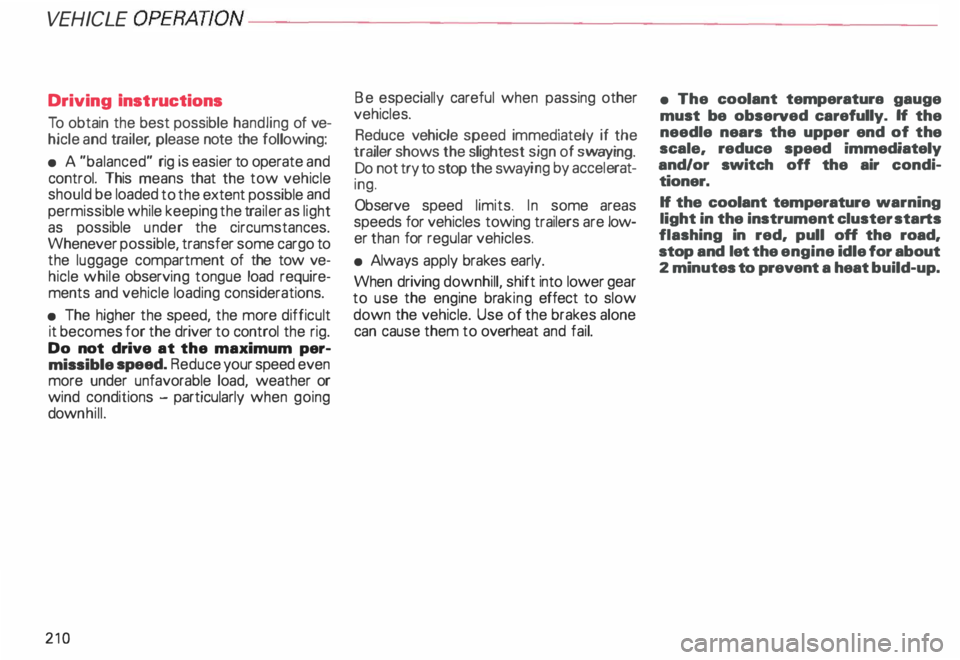
VEHICLE OPER
ATION-----------------------
Driving Instructions
To obtain the best possible handling of ve
hicle and trailer , please note the following:
• A "balanced" rig is easier to operate and
control. This means that the tow vehicle
should be loaded to the extent possible and
permissible while keeping the trailer as light
as possible under the circumstances.
Whenever possible, transfer some cargo to
the luggage compartment of the tow ve
hicle while observing tongue load require
ments and vehicle loading considerations.
• The higher the speed, the more difficult
it becomes for the driver to control the rig.
Do not drive at the maximum per
missible speed. Reduce your speed even
more under unfavorable load, weather or
wind conditions - particularly when going
dow nhill.
210 Be
especially careful when passing other
vehicles.
Reduce vehicle speed immediately if the
trailer shows the slightest sign of swaying.
Do not try to stop the sway ing by accel erat
ing.
Observe speed limits. In some areas
speeds for vehicles towing trailers are low
er than for regular vehicles.
• Always apply brakes early.
When driving downhill, shift into lower gear
to use the engine braking effect to slow
down the vehicle. Use of the brakes alone
can cause them to overheat and fail. •
The coolant temperatura gauge
must be observed carefully. H the
needle nears the upper end of the
scale, reduce speed immediately
and/or switch off the air condi
tioner.
If the coolant temperature warning
light in the instrument cluster starts
flashing in red, pull off the road,
stop and let the engine idle for about
2 minutes to prevent a heat build-up.
Page 212 of 306
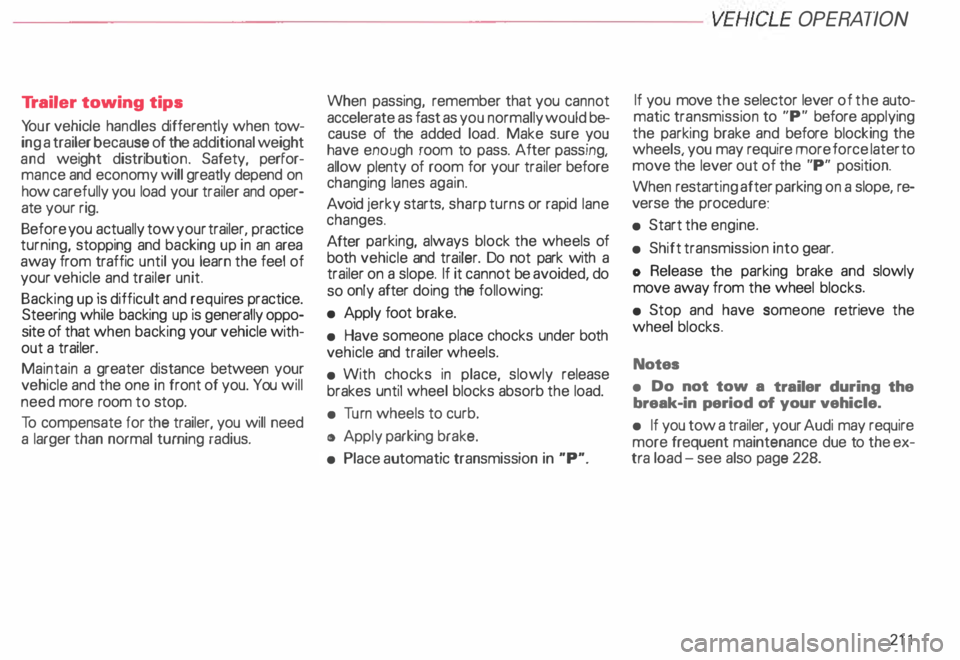
-----------------------VEHICL E OPER ATION
Tr ailer towing tips
Yo ur vehicle handles differently when tow
ing a trailer because of the additional weight
and weight distribution. Safety, perfor
mance and economy will greatly depend on
how carefully you load your trailer and oper
ate your rig.
Before you actually tow your trailer, practice
turning, stopping and backing up in an area
away from traffic until you learn the feel of
your vehicle and trailer unit.
Backing up is difficult and requir es practice.
Steering while backing up is generally oppo
site of that when backing your vehicle with
out a trailer.
Maintain a greater distance between your
vehicle and the one in front of you. You will
need more room to stop.
To compensate for the trailer, you will need
a larger than normal turning radius. When
passing, remember that you cannot
accelerate as fast as you normally would be
cause of the added load. Make sure you
have enough room to pass. After passing,
allow plenty of room for your trailer before
changing lanes again.
Avoid jerky starts, sharp turns or rapid lane
changes.
After parking, always block the wheels of
both vehicle and trailer. Do not park with a
trailer on a slope. If it cannot be avoided, do
so only after doing the following:
• Apply foot brake.
• Have someone place chocks under both
vehicle and trailer wheels.
• With chocks in place, slowly release
brakes until wheel blocks absorb the load.
• Turn wheels to curb.
o Apply parking brake.
• Place automatic transmission in "P". If
you move the selector lever of the auto
matic transmission to "P" before applying
the parking brake and before blocking the
wheels, you may require more force later to
move the lever out of the "P" position.
When restarting after parking on a slope, re
verse the procedure:
• Start the engine.
• Shift transmission into gear.
o Release the parking brake and slowly
move away from the wheel blocks.
• Stop and have someone retrieve the
wheel blocks.
Notes
• Do not tow a trailer during the
break-in period of your vehicle.
• If you tow a trailer, your Audi may require
more frequent maintenance due to the ex
tra load -see also page 228.
211
Page 229 of 306

VEHICLE
CARE---------------------------------------------------
Maintenance
Yo ur vehicle has been designed to help
keep maintenance requirements to a mini
mum.
However. a certa in amount of regular main
tenance is still necessary to assure your ve
hic le's safety, economy and reliabili ty.
c£> By regularly maintaining your
vehicle, you help make sure that
emission standards are maintai ned,
thus minimizing adverse effects on
the envir onment.
For detailed vehicle maintenance consult
your Maintenance booklet.
Under difficult operating condi
tions, for example at extremely low out
side temperatures, in very dusty regions,
when towing a trailer very frequently, etc.,
some service work should be performed
between the intervals specified.
This applies particularly to:
• oil changes, and
• cleaning or replacing the air filter.
228 Important
considerations for
you and your vehicle:
The increasing use of electr onics, sophisti
cated fuel injection and emission control
systems, and the generally increasing tech
nical complexity of today's automobiles,
have steadily reduced the scope of mainte
nance and repairs which can be carried out
by vehicle owners. Also, safety and en
vironmental concerns place very strict
limi ts on the nature of repairs and adjust
ments to engine and transmission parts
which an owner can perform . Main
tenance, adjustments and repairs usu
ally require special tools, testing devices
and other equipment available to specially
trained workshop personnel in order to as
sure proper performance, reliability and
safety of the vehicle and its many systems.
Impr oper maintenan ce, adjustments and
repairs can impair the operation and reliabil
ity of your vehicle and even void your ve
hicle warranty. Therefore, proof of servicing
in accordance with the maintenance
schedule may be a condition for upholding
a possible warranty claim made within the
warranty period.
Above all, operational safety can be ad
versely affected, creating unnecessary
risks for you and your passengers.
Page 263 of 306
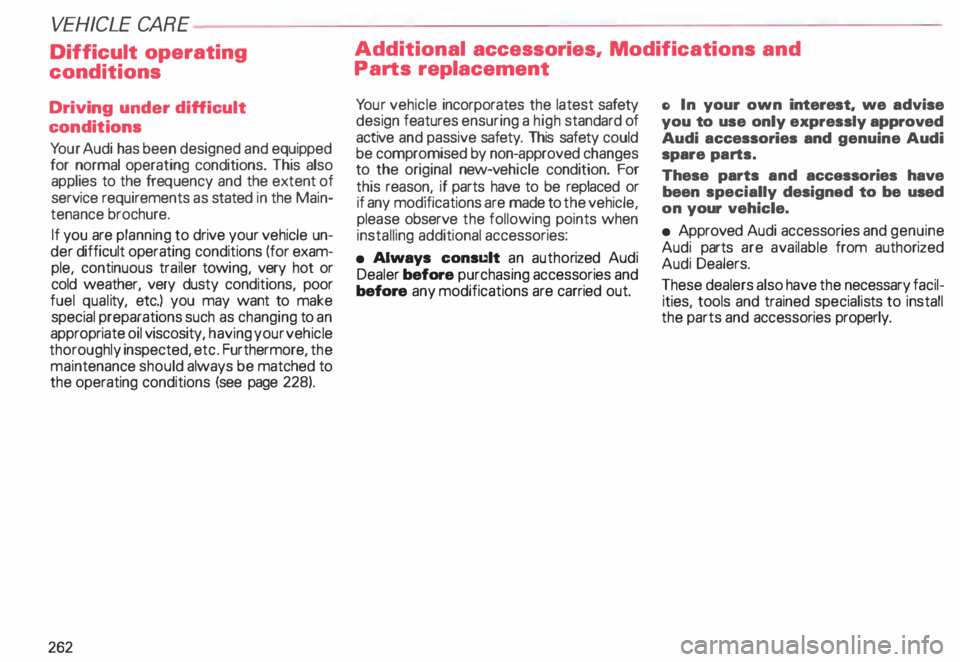
VE
HICLE CARE
Difficult operating
conditions
Driving under difficult
conditions
Yo ur Audi has been designed and equipped
for normal operating conditions. This also
applies to the freq uency and the extent of
service requirements as stated in the Main
tenance brochure.
If you are planning to drive your vehicle un
der difficult operating conditions (for exam
ple, continuous trailer towing, very hot or
cold weather, very dusty conditions, poor
fuel quality, etc.) you may want to make
special preparations such as changing to an
appropriate oil viscosity, having your vehicle
thoroughly inspected, etc. Furthermore, the
main tenance should always be matched to
the operating conditions (see page 228).
262 Additional
accessories, Modifications and
Parts replacement
Yo ur vehicle incorporates the latest safety
design features ensuring a high standard of
active and passive safety. This safety could
be compromised by non-approved changes
to the original new-vehicle condition. For
this reason, if parts have to be replaced or
if any modifications are made to the vehicle,
please observe the following points when
installing additional accessories:
• Always cons�lt an author ized Audi
Dealer before purchasing accessories and
before any modifications are carried out. Cl
In your own interest, we advise
you to use only expressly approved
Audi accessories and genuine Audi
spare parts.
These parts and accessories have
been specially designed to be used
on your vehicle.
• Approved Audi accessories and genuine
Audi parts are available from authorized
Audi Dealers.
These dealers also have the necessary facil
ities, tools and trained specialists to install
the parts and accessories properly.
Page 266 of 306
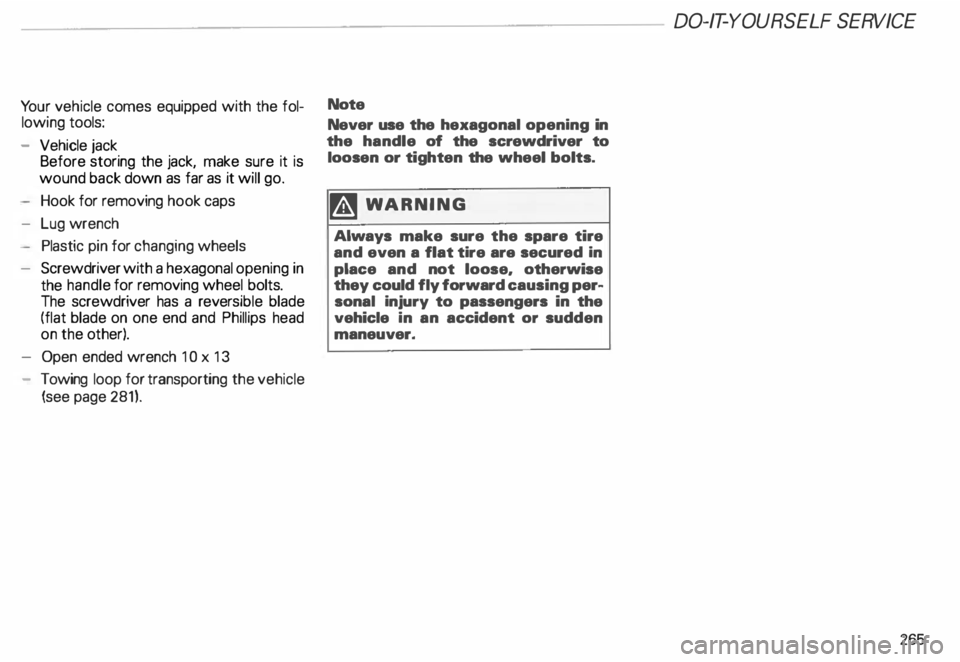
Yo
ur vehicle comes equipped with the fol
lowing tools:
- Vehicle jack
Before storing the jack, make sure it is
wound back down as far as it will go.
Hook for removing hook caps
- Lug wrench
Plastic pin for changing wheels
- Screwdriver with a hexagonal opening in
the handle for removing wheel bolts.
The screwdriver has a rever sible blade
(flat blade on one end and Phillips head
on the other).
- Open ended wrench 1 0 x 13
- Towing loop for transporting the vehicle
(see page 281). Note
Never
use the hexagonal opening in
the handle of the screwdriver to
loosen or tighten the wheel bolts.
�W ARNING
Always make sure the spare tire
and even a flat tire are secured in
place and not loose, otherwise
they could fly forward causing per
sonal injury to passengers in the
vehicle in an accident or sudden
maneuver. DO-IT-YOURSELF
SERVICE
265
Page 268 of 306

•
The deflated full size spare tire cannot be
repaired or mounted using conventional
shop equipment. This work always has to
be performed by the man ufacturer of the
collapsible tire.
• All the air must be let out of the tire after
use before stowing it in the storage area
prov ided for it in the vehicle. Once all the air
is out, the tire will return to its original form.
To let the air out of the tire, either use a
sharp object to press down on the metal pin
in the valve, or use the valve-remo ving tool
on the back side of the dust cap to unscrew
the valve stem. Changing
a wheel
�W ARNING
You or your passengers could be
injured while changing a wheel if
you do not follow safety precau
tions:
• If you have a flat tire, move a
safe distance off the road. Turn off
the engine, turn the emergency
flasher on and use other warning
devices to alert other motorists.
• Passengers must not rema in in
the vehicle when it is jacked up.
This includes children as well as
adults.
• Make sure that passengers wait
in a safe place away from the ve
hicle and well away from the road
way and traffic.
• Before you change a wheel, be
sure the ground is level and firm.
If necessary, use a sturdy board
under the jack. DO-IT-YOURSELF
SERVICE
�� WARN ING continued
• After installing the spare wheel,
make sure that you remount the
flat tire/Wheel in its storage area
properly and tighten the plastic
knurled screw securely.
• To help prevent the vehicle from
moving suddenly and possibly
slipping off the jack, always fully
set the parking brake and block
the wheel diagonally opposite the
wheel being changed. When one
front wheel is lifted off the
ground, placing the automatic
transmission in P (Park) will not
prevent vehicle movement.
267
Page 279 of 306
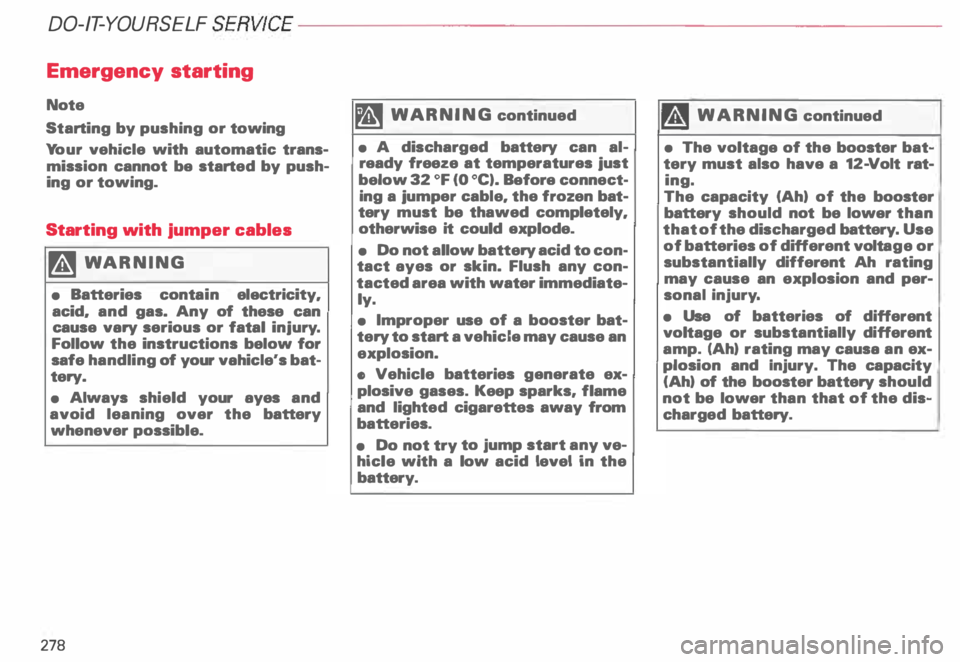
DO-IT-Y
OURSELF SERVICE----------------------
Emergency starting
Note
Starting by pushing or towing
Yo ur vehicle with automatic trans
mission cannot be started by push
ing or towing.
Star ting with jumper cables
�W ARNING
• Batteries contain electricity.
acid. and gas. Any of these can
cause vary serious or fatal injury.
Follow the instructions below for
safe handling of your vahicle"s bat·
tery.
• Always shield your ayes and
avoid leaning over the battery
whenever possible.
278 �,
WAR NING continued
• A discharged battery can al
ready freeze at temperatures just
below 32 °F (0 °C). Before connect·
ing a jumper cable. the frozen bat
tery must be thawed completely.
otherwise it could explode.
• Do not allow battery acid to con·
tact ayes or skin. Flush any con
tacted area with water immediate
ly.
• Improper use of a booster bat
tery to start a vehicle may cause an
explosion.
• Vehicle batteries generate ex
plosive gases. Keep sparks. flame
and lighted cigarettes away from
batteries.
• Do not try to jump start any ve
hicle with a low acid level in the
battery. ,Al
WARNING continued
• The voltage of the booster bat
tery must also have a 12- Volt rat
ing.
The capacity (Ah) of the booster
battery should not be lower than
that of the discharged battery. Use
of batteries of different voltage or
substantially different Ah rating
may cause an explosion and per
sonal injur y.
• Use of batteries of different
voltage or substantially different
amp. (Ah) rating may causa an ex
plosion and Injury. The capacity
(Ah) of the booster battery should
not be lower than that of the dis
charged battery.
Page 282 of 306
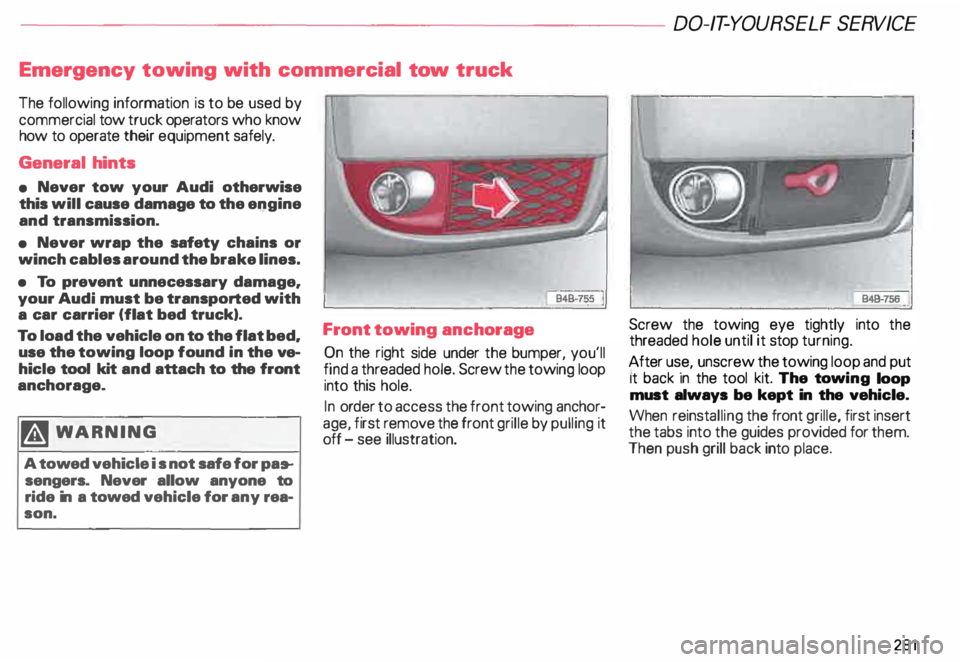
---------------------DO-IT-YOURSEL F SERVICE
Emergency towing with commercial tow truck
The following information is to be used by
commercial tow truck operators who know
how to operate their equipment safely.
General hints
• Never tow your Audi otherwise
this will cause damage to the engine
and transmission.
• Never wrap the safety chains or
winch cables around the brake lines.
• To prevent unnecessary damage.
your Audi must be transported with
a car carrier (flat bed truck).
To load the vehicle on to the flat bed.
use the towing loop found in the ve
hicle tool kit and attach to the front
anchorage.
�W ARNING
A towed vehicle is not safe for pas
sengers. Never allow anyone to
ride in a towed vehicle for any rea
son. Front towing
anchorage
C? n the right side under the bumper, you'll
fmd a threaded hole. Screw the towing loop
into this hole.
In ord .er to access the front towing anchor
age, f1rst remove the front grille by pulling it
off -see illustration. Screw the towing eye tightly
into the
threaded hole until it stop turning.
After us .e, unscrew the towing loop and put
1t back In the tool kit. The towing loop
must always be kept in the vehicle.
When reinstalling the front grille, first insert
the tabs into the guides provided for them.
Then push grill back into place.
281